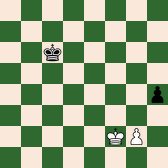After nine rounds of the 11-round US championship, grandmaster Wesley So leads with 8 points. GMs Jeffery Xiong and Ray Robson are tied with 7.
In round 9 on Wednesday, So and Robson — seconds apart — simplified to pure pawn endings (the easiest type of ending to win) by sacrificing rooks for bishops when they knew their kings would occupy a critical square afterward.
In any endgame of king plus pawn vs. king, the strong side should suss at a glance if it’s a win by either 1) queening the pawn because the enemy king is “outside the square of the pawn“, or 2) occupying one of the pawn’s “critical squares” with the king.
Source image for thumbnails.
